The Cambridge History of Japan, Vol. 4: Early Modern Japan
Подождите немного. Документ загружается.

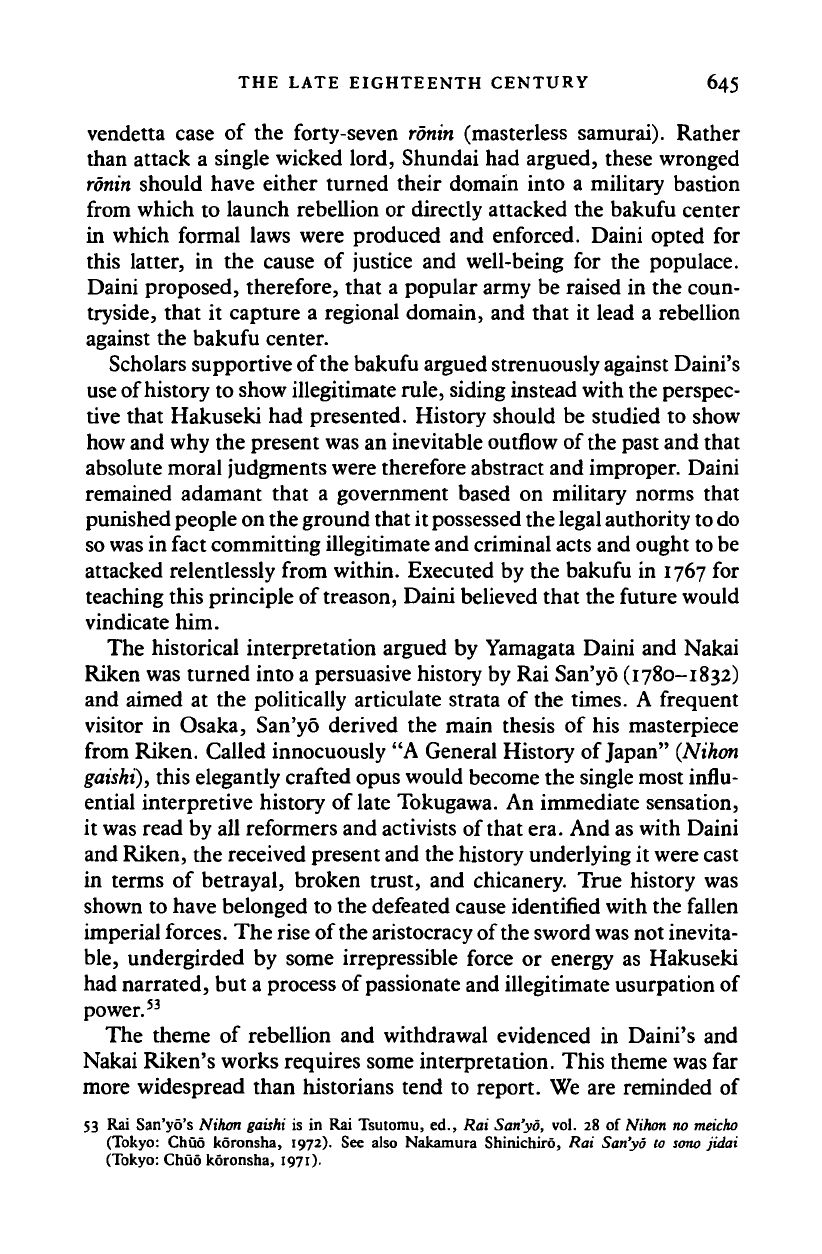
THE LATE EIGHTEENTH CENTURY 645
vendetta case of the forty-seven
ronin
(masterless samurai). Rather
than attack a single wicked lord, Shundai had argued, these wronged
ronin
should have either turned their domain into a military bastion
from which to launch rebellion or directly attacked the bakufu center
in which formal laws were produced and enforced. Daini opted for
this latter, in the cause of justice and well-being for the populace.
Daini proposed, therefore, that a popular army be raised in the coun-
tryside, that it capture a regional domain, and that it lead a rebellion
against the bakufu center.
Scholars supportive of the bakufu argued strenuously against Daini's
use of history to show illegitimate rule, siding instead with the perspec-
tive that Hakuseki had presented. History should be studied to show
how and why the present was an inevitable outflow of
the
past and that
absolute moral judgments were therefore abstract and improper. Daini
remained adamant that a government based on military norms that
punished people on the ground that it possessed the
legal
authority
to
do
so was
in fact committing illegitimate and criminal acts and ought to be
attacked relentlessly from within. Executed by the bakufu in 1767 for
teaching this principle of
treason,
Daini believed that the future would
vindicate him.
The historical interpretation argued by Yamagata Daini and Nakai
Riken was turned into a persuasive history by Rai San'yo (1780-1832)
and aimed at the politically articulate strata of the times. A frequent
visitor in Osaka, San'yo derived the main thesis of his masterpiece
from Riken. Called innocuously "A General History of
Japan"
(Nihon
gaishi),
this elegantly crafted opus would become the single most influ-
ential interpretive history of late Tokugawa. An immediate sensation,
it was read by all reformers and activists of that era. And as with Daini
and Riken, the received present and the history underlying it were cast
in terms of betrayal, broken trust, and chicanery. True history was
shown to have belonged to the defeated cause identified with the fallen
imperial forces. The rise of the aristocracy of the sword
was
not inevita-
ble,
undergirded by some irrepressible force or energy as Hakuseki
had narrated, but a process of passionate and illegitimate usurpation of
power.
53
The theme of rebellion and withdrawal evidenced in Daini's and
Nakai Riken's works requires some interpretation. This theme was far
more widespread than historians tend to report. We are reminded of
53 Rai San'yo's Nihon gaishi is in Rai Tsutomu, ed., Rai San'yo, vol. 28 of Nihon no meicho
(Tokyo: Chuo koronsha, 1972). See also Nakamura Shinichiro, Rai San'yo to sono jidai
(Tokyo: Chuo koronsha, 1971).
Cambridge Histories Online © Cambridge University Press, 2008
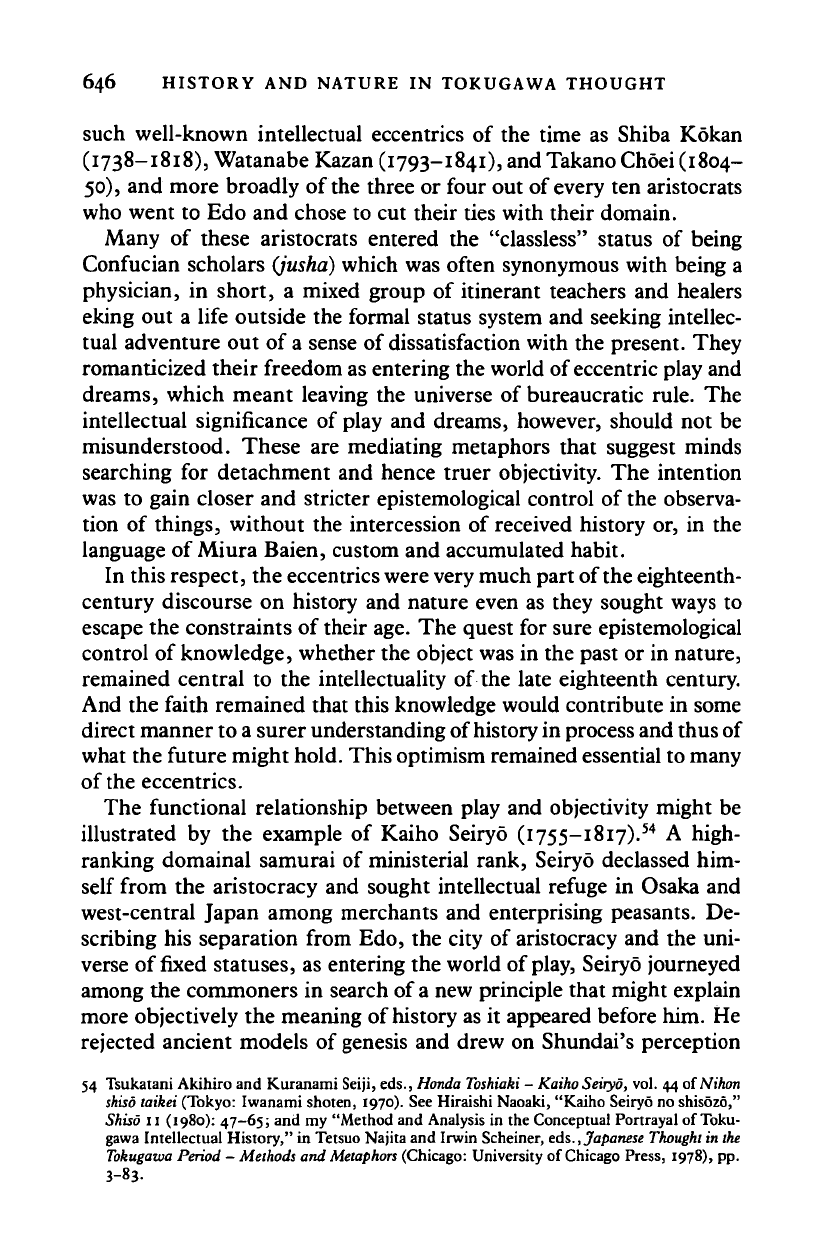
646 HISTORY AND NATURE IN TOKUGAWA THOUGHT
such well-known intellectual eccentrics of the time as Shiba Kokan
(1738-1818), Watanabe Kazan (1793-1841), and Takano Choei (1804-
50),
and more broadly of the three or four out of every ten aristocrats
who went to Edo and chose to cut their ties with their domain.
Many of these aristocrats entered the "classless" status of being
Confucian scholars
(jusha)
which was often synonymous with being a
physician, in short, a mixed group of itinerant teachers and healers
eking out a life outside the formal status system and seeking intellec-
tual adventure out of
a
sense of dissatisfaction with the present. They
romanticized their freedom as entering the world of eccentric play and
dreams, which meant leaving the universe of bureaucratic rule. The
intellectual significance of play and dreams, however, should not be
misunderstood. These are mediating metaphors that suggest minds
searching for detachment and hence truer objectivity. The intention
was to gain closer and stricter epistemological control of the observa-
tion of things, without the intercession of received history or, in the
language of Miura Baien, custom and accumulated habit.
In this respect, the eccentrics were very much part of the eighteenth-
century discourse on history and nature even as they sought ways to
escape the constraints of their age. The quest for sure epistemological
control of knowledge, whether the object was in the past or in nature,
remained central to the intellectuality of the late eighteenth century.
And the faith remained that this knowledge would contribute in some
direct manner to a surer understanding of history in process and thus
of
what the future might hold. This optimism remained essential to many
of the eccentrics.
The functional relationship between play and objectivity might be
illustrated by the example of Kaiho Seiryo (1755-1817).
54
A high-
ranking domainal samurai of ministerial rank, Seiryo declassed him-
self from the aristocracy and sought intellectual refuge in Osaka and
west-central Japan among merchants and enterprising peasants. De-
scribing his separation from Edo, the city of aristocracy and the uni-
verse of fixed statuses, as entering the world of
play,
Seiryo journeyed
among the commoners in search of
a
new principle that might explain
more objectively the meaning of history as it appeared before him. He
rejected ancient models of genesis and drew on Shundai's perception
54 Tsukatani Akihiro and Kuranami Seiji, eds., Honda Toshiaki - Kaiho Seiryo, vol. 44 ofNihon
shiso
laikei (Tokyo: Iwanami shoten, 1970). See Hiraishi Naoaki, "Kaiho Seiryo no shisozo,"
Shiso 11 (1980): 47-65; and my "Method and Analysis in the Conceptual Portrayal of Toku-
gawa Intellectual History," in Tetsuo Najita and Irwin Scheiner,
eds.,
Japanese Thought in the
Tokugawa Period - Methods and Metaphors (Chicago: University of Chicago Press, 1978), pp.
3-83.
Cambridge Histories Online © Cambridge University Press, 2008

THE LATE EIGHTEENTH CENTURY 647
of the crucial significance of trade or, more fundamentally, the princi-
ple of economic exchange, agreeing with him that land alone could no
longer sustain society. Seiryo therefore entered the world of play to
uncover the reasons for the merchants' effectiveness in controlling the
process of commerce.
As
he journeyed in Osaka and the countryside lecturing on Taoism -
the philosophy of play - Seiryo formed a perspective on the historical
present that said that the future belonged to the merchants and, more
specifically, to the economic epistemology they controlled. The so-
called
way
of
the
merchants contained
a
principle of mathematical preci-
sion that served as a controllable norm. The very idea of an exact
interest rate
was
calculated
so as
to be fair and beneficial to the exchang-
ing
parties.
The emotional reading that trade was
a
passionate act moti-
vated by greed, Seiryo therefore contended, was irrational and indeed
arbitrary, determined by the customary views of Confucian
ethics.
The
calculation of profit, he emphasized, was in fact the exercise of universal
mathematical reason
(sansu).
From this observation that commoners in
fact dealt with their world in terms of universal norms of knowledge,
Seiryo decided that the future belonged to the merchants, as men in
government did not govern in terms of that principle. The principle of
exactitude, of precise measurability
(menokozanyo),
a term widely used
among merchants, must indeed be the dynamic in the present. It was a
principle, moreover, that accorded with nature in the sense that peas-
ants calculate accurately what
is
to be derived from nature
in
accordance
with what is given to it. That principle of exchange applied to society
was trade as measured in mathematical terms.
The iconoclasm issuing from this excursion into the world of play is
quite clear. It did not mean for Seiryo doing nothing, as Shundai
suggested ironically. It meant, rather, uncovering, through severance
from the existing structure of authority in the world of play, epistemo-
logical certitude with which the present, as received from the past,
might be objectively assessed. The system of social classes that was
justified in ethical historical terms, Seiryo now argued to be errone-
ous.
Classes were functional and internally defined as terms of the
universal principle of exchange so that, in the end, classes were not
moral but economic in character. Although the aristocracy may have
more bureaucratic responsibilities, Seiryo argued, merchants and peas-
ant entrepreneurs knew this principle far better than do those in posi-
tions of power.
Seiryo thus challenged the existing conceptions of virtue. Virtue was
not pinned to a universal moral norm, but to a principle of calculation.
Cambridge Histories Online © Cambridge University Press, 2008
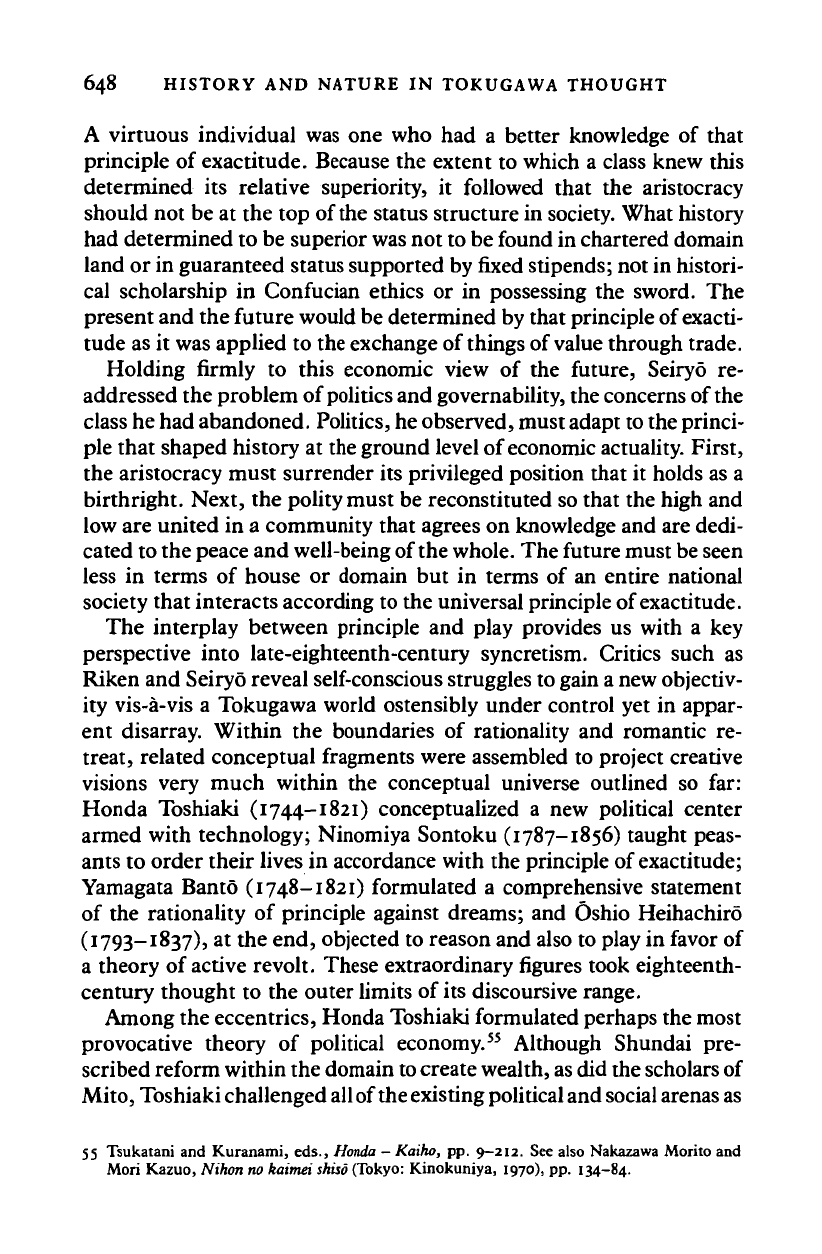
648 HISTORY AND NATURE IN TOKUGAWA THOUGHT
A virtuous individual was one who had a better knowledge of that
principle of exactitude. Because the extent to which a class knew this
determined its relative superiority, it followed that the aristocracy
should not be at the top of the status structure in society. What history
had determined to be superior was not to be found in chartered domain
land or in guaranteed status supported by
fixed
stipends; not in histori-
cal scholarship in Confucian ethics or in possessing the sword. The
present and the future would be determined by that principle of exacti-
tude as it was applied to the exchange of things of value through trade.
Holding firmly to this economic view of the future, Seiryo re-
addressed the problem of politics and governability, the concerns of the
class he had abandoned. Politics, he observed, must adapt to the princi-
ple that shaped history at the ground level of economic actuality. First,
the aristocracy must surrender its privileged position that it holds as a
birthright. Next, the polity must be reconstituted so that the high and
low are united in a community that agrees on knowledge and are dedi-
cated to the peace and well-being of the
whole.
The future must be seen
less in terms of house or domain but in terms of an entire national
society that interacts according to the universal principle of exactitude.
The interplay between principle and play provides us with a key
perspective into late-eighteenth-century syncretism. Critics such as
Riken and Seiryo reveal self-conscious struggles to gain
a
new objectiv-
ity vis-a-vis a Tokugawa world ostensibly under control yet in appar-
ent disarray. Within the boundaries of rationality and romantic re-
treat, related conceptual fragments were assembled to project creative
visions very much within the conceptual universe outlined so far:
Honda Toshiaki (1744-1821) conceptualized a new political center
armed with technology; Ninomiya Sontoku (1787-1856) taught peas-
ants to order their lives in accordance with the principle of exactitude;
Yamagata Banto (1748-1821) formulated a comprehensive statement
of the rationality of principle against dreams; and Oshio Heihachiro
(1793-1837), at the end, objected to reason and also to play in favor of
a theory of active revolt. These extraordinary figures took eighteenth-
century thought to the outer limits of its discoursive range.
Among the eccentrics, Honda Toshiaki formulated perhaps the most
provocative theory of political economy.
55
Although Shundai pre-
scribed reform within the domain
to
create wealth,
as
did the scholars
of
Mito,
Toshiaki challenged all of the existing political and social arenas as
55 Tsukatani and Kuranami, eds., Honda - Kaiho, pp. 9-212. See also Nakazawa Morito and
Mori Kazuo, Nihon no kaimei
shiso
(Tokyo: Kinokuniya, 1970), pp. 134-84.
Cambridge Histories Online © Cambridge University Press, 2008

THE LATE EIGHTEENTH CENTURY 649
anachronistic. He rejected the status system, the domain, the house,
and the overall conception of noncentralized governance
(hoken)
on
which
the
regime
rested.
Indeed, the bakufu's policy of territorial seclu-
sion, of limiting political space in order to exercise virtue, Toshiaki
believed to be, in the long run, self-defeating.
To
create wealth and save
the nation, political spaces must be thoroughly redefined, a fact that in
turn would require the acquisition of
new
knowledge and the selection
of talent based on this knowledge. In short, the ideas of reform con-
ceived within the domain and of principle
as
systematic calculation were
now, in the hands of Toshiaki, rearticulated in terms of
a
restructured
and centralized nation state and state interest.
The crisis in Japan, Toshiaki reasoned, was not attributable to moral
decline but to the contradiction between fixed land area and hence the
limited production of goods, relative to the natural growth of the
population. The problems afflicting the nation could not be resolved
until that elemental relationship between land and population was first
grasped. The very concept of territorial seclusion was untenable. As
this contradiction was not peculiar to Japan and all nations faced it in
relative degrees, the problem was best seen as being not merely domes-
tic but also international in character. The provocative appearance of
Western ships in Asian waters in the 1790s Toshiaki interpreted as
extensions of that very contradiction in European nations. The aban-
donment of the static idea of splendid isolation, moreover, entailed the
added consequence that the nation must pursue its interest as a com-
petitive trading nation on the high seas. Whereas Shundai had earlier
urged that domains involve themselves in active interdomainal trade,
exchanging surplus for scarce goods, Toshiaki now extended this idea
to the international level.
The creation of wealth through international trade, however, must
include the adoption of new knowledge appropriate to a dynamic, as
opposed to a static, conception of
space.
Here Toshiaki pointed to the
vast scientific and technological knowledge of Western trading na-
tions,
compared with that of Japan which still relied on moral apho-
risms drawn from Confucianism, Buddhism, and Shinto, all of which
Toshiaki denounced as pedantic, superstitious, or ludicrous.
In his
Keisei
hisaku (Secret proposals on political economy, 1798),
Toshiaki explained what he meant by the kind of new technological
knowledge and the specific uses for it that he had in mind.
56
First, he
56 Tsukatani and Kuranami, eds., Honda - Kaiho, pp. 12-43. See also Donald Keene, The
Japanese Discovery of Europe, 1720-1830 (Palo Alto,
Calif.:
Stanford University Press, 1969),
pp.
59-122, 175-226, for translations of Honda.
Cambridge Histories Online © Cambridge University Press, 2008
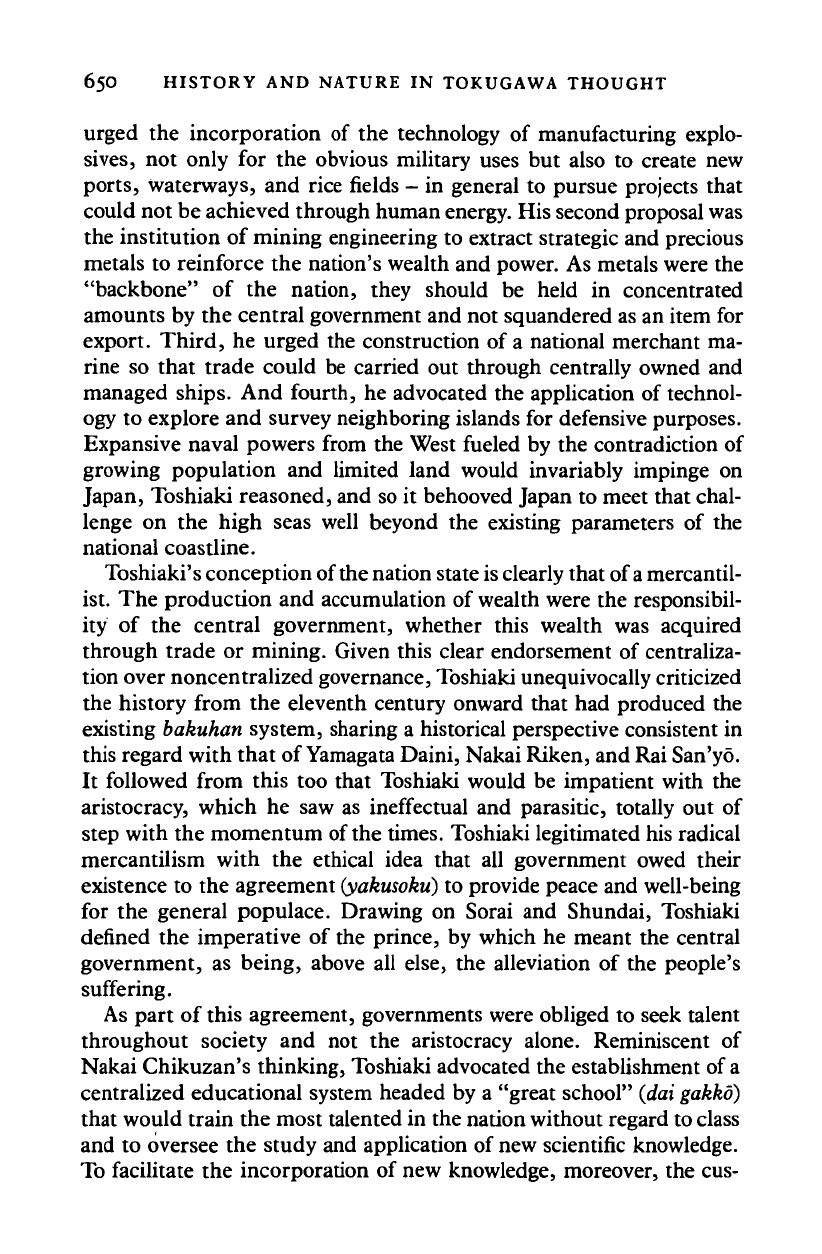
650 HISTORY AND NATURE IN TOKUGAWA THOUGHT
urged the incorporation of the technology of manufacturing explo-
sives,
not only for the obvious military uses but also to create new
ports,
waterways, and rice fields - in general to pursue projects that
could not be achieved through human
energy.
His second proposal was
the institution of mining engineering to extract strategic and precious
metals to reinforce the nation's wealth and power. As metals were the
"backbone" of the nation, they should be held in concentrated
amounts by the central government and not squandered as an item for
export. Third, he urged the construction of a national merchant ma-
rine so that trade could be carried out through centrally owned and
managed ships. And fourth, he advocated the application of technol-
ogy to explore and survey neighboring islands for defensive purposes.
Expansive naval powers from the West fueled by the contradiction of
growing population and limited land would invariably impinge on
Japan, Toshiaki reasoned, and so it behooved Japan to meet that chal-
lenge on the high seas well beyond the existing parameters of the
national coastline.
Toshiaki's conception of the nation state is clearly that of
a
mercantil-
ist. The production and accumulation of wealth were the responsibil-
ity of the central government, whether this wealth was acquired
through trade or mining. Given this clear endorsement of centraliza-
tion over noncentralized governance, Toshiaki unequivocally criticized
the history from the eleventh century onward that had produced the
existing bakuhan system, sharing a historical perspective consistent in
this regard with that of Yamagata Daini, Nakai Riken, and Rai San'yo.
It followed from this too that Toshiaki would be impatient with the
aristocracy, which he saw as ineffectual and parasitic, totally out of
step with the momentum of the times. Toshiaki legitimated his radical
mercantilism with the ethical idea that all government owed their
existence to the agreement
{yakusoku)
to provide peace and well-being
for the general populace. Drawing on Sorai and Shundai, Toshiaki
denned the imperative of the prince, by which he meant the central
government, as being, above all else, the alleviation of the people's
suffering.
As part of this agreement, governments were obliged to seek talent
throughout society and not the aristocracy alone. Reminiscent of
Nakai Chikuzan's thinking, Toshiaki advocated the establishment of
a
centralized educational system headed by a "great school"
(dai gakko)
that would train the most talented in the nation without regard to class
and to oversee the study and application of new scientific knowledge.
To facilitate the incorporation of new knowledge, moreover, the cus-
Cambridge Histories Online © Cambridge University Press, 2008

THE LATE EIGHTEENTH CENTURY 65I
torn of relying on Chinese characters would be abandoned,
as
memoriz-
ing the tens of thousands of them was intellectually distracting and
anachronistic. Just as Europe made creative achievements in science
by ending its relationship with Roman civilization, so too Japan must
now end its cultural ties with China and, by relying on the Japanese
syllabary, set out to study the sciences of mathematics and physics.
Toshiaki's vision should not be seen as an isolated one. In other
parts of society, too, as in the villages, the issue of organization and
knowledge had become pressing issues. At stake were peasants saving
themselves without relying on the exercise of benevolence from above.
Perhaps the most revered and influential sage to emerge from this
development was Ninomiya Sontoku, a self-educated peasant who
created a vision of peasants controlling their destiny through system-
atic knowledge. Whereas Toshiaki's vision called for a reorganized
political center "saving" people, Sontoku addressed his to peasants
saving the nation. These were parallel yet related visions emerging out
of
the
late-eighteenth-century intellectual history of political economy.
Sontoku drew from a variety of sources to form a coherent body of
ideas oriented to peasant action in the expanding universe of commer-
cial agriculture.
57
Consistent with the tradition of agronomy begun by
Kaibara Ekken and Miyazaki Yasusada, Sontoku emphasized the im-
portance of action vis-a-vis nature as the universal absolute. One did
not study history
to
act in nature, although history may provide sugges-
tive insights into the attitude that one might adopt. History more
basically was resolving the immediate problems of poverty in relation
to nature as a given.
All human beings, Sontoku believed, were endowed by nature or
Heaven with a virtue (toku) that was unrelated to the status distinc-
tions made in society. As this virtue was a universal blessing (on), it
was the responsibility of all human beings to act it out in works of
thanksgiving. And because the gift was neither haphazard nor arbi-
trary, people must likewise respond in a manner that was systematic
and principled, regardless of the particular function. For farmers,
Sontoku elaborated, the engagement with nature must be objective
and based on firm knowledge, never on guesswork. It involved know-
ing precisely what nature could or could not yield. Forms of knowl-
edge that did not contribute to this exercise of virtue ought to be
57 Naramoto Tatsuya and Nakai Nobuhiko, eds., Ninomiya Sontoku - Ohara Yugaku, vol. 52 of
Nihon shiso taikei (Tokyo: Iwanami shoten, 1973), pp. 10-234; and Yokokawa Shiro, ed.,
Ninomiya Sontoku shu, vol. 5 of Kinsei shakai keizai gakuseisu taikei (Tokyo: Seibundo
shinkosha, 1935). See also Bellah,
Tokugawa
Religion, pp. 127-30.
Cambridge Histories Online © Cambridge University Press, 2008
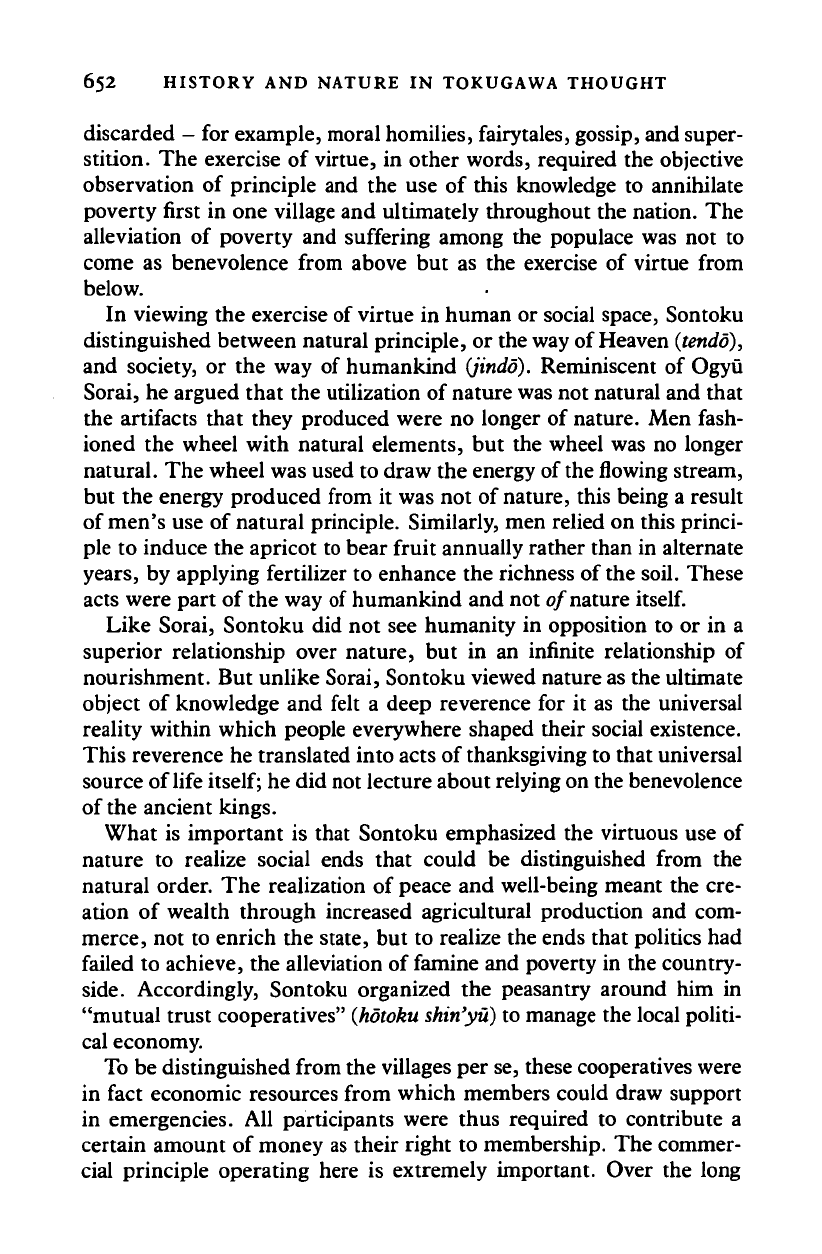
652 HISTORY
AND
NATURE
IN
TOKUGAWA THOUGHT
discarded
- for
example, moral homilies, fairytales, gossip,
and
super-
stition.
The
exercise
of
virtue,
in
other words, required
the
objective
observation
of
principle
and the use of
this knowledge
to
annihilate
poverty first
in one
village
and
ultimately throughout
the
nation.
The
alleviation
of
poverty
and
suffering among
the
populace
was not to
come
as
benevolence from above
but as the
exercise
of
virtue from
below.
In viewing
the
exercise
of
virtue
in
human
or
social space, Sontoku
distinguished between natural principle,
or
the way
of
Heaven
(tendd),
and society,
or the way of
humankind
(jindo).
Reminiscent
of
Ogyu
Sorai,
he
argued that
the
utilization
of
nature was
not
natural
and
that
the artifacts that they produced were
no
longer
of
nature.
Men
fash-
ioned
the
wheel with natural elements,
but the
wheel
was no
longer
natural.
The
wheel was used
to
draw
the
energy
of
the
flowing stream,
but
the
energy produced from
it was not of
nature, this being
a
result
of men's
use of
natural principle. Similarly,
men
relied
on
this princi-
ple
to
induce
the
apricot
to
bear fruit annually rather than
in
alternate
years,
by
applying fertilizer
to
enhance
the
richness
of
the soil. These
acts were part
of
the
way of
humankind
and not
of nature
itself.
Like Sorai, Sontoku
did not see
humanity
in
opposition
to or in a
superior relationship over nature,
but in an
infinite relationship
of
nourishment.
But
unlike Sorai, Sontoku viewed nature
as the
ultimate
object
of
knowledge
and
felt
a
deep reverence
for it as the
universal
reality within which people everywhere shaped their social existence.
This reverence
he
translated into acts
of
thanksgiving
to
that universal
source of life
itself; he did
not lecture about relying on
the
benevolence
of the ancient kings.
What
is
important
is
that Sontoku emphasized
the
virtuous
use of
nature
to
realize social ends that could
be
distinguished from
the
natural order.
The
realization
of
peace
and
well-being meant
the cre-
ation
of
wealth through increased agricultural production
and com-
merce,
not to
enrich
the
state,
but to
realize
the
ends that politics
had
failed
to
achieve,
the
alleviation
of
famine
and
poverty
in the
country-
side.
Accordingly, Sontoku organized
the
peasantry around
him in
"mutual trust cooperatives"
(hotoku shin'yu)
to
manage
the
local politi-
cal economy.
To
be
distinguished from
the
villages
per
se, these cooperatives were
in fact economic resources from which members could draw support
in emergencies.
All
participants were thus required
to
contribute
a
certain amount
of
money
as
their right
to
membership.
The
commer-
cial principle operating here
is
extremely important. Over
the
long
Cambridge Histories Online © Cambridge University Press, 2008
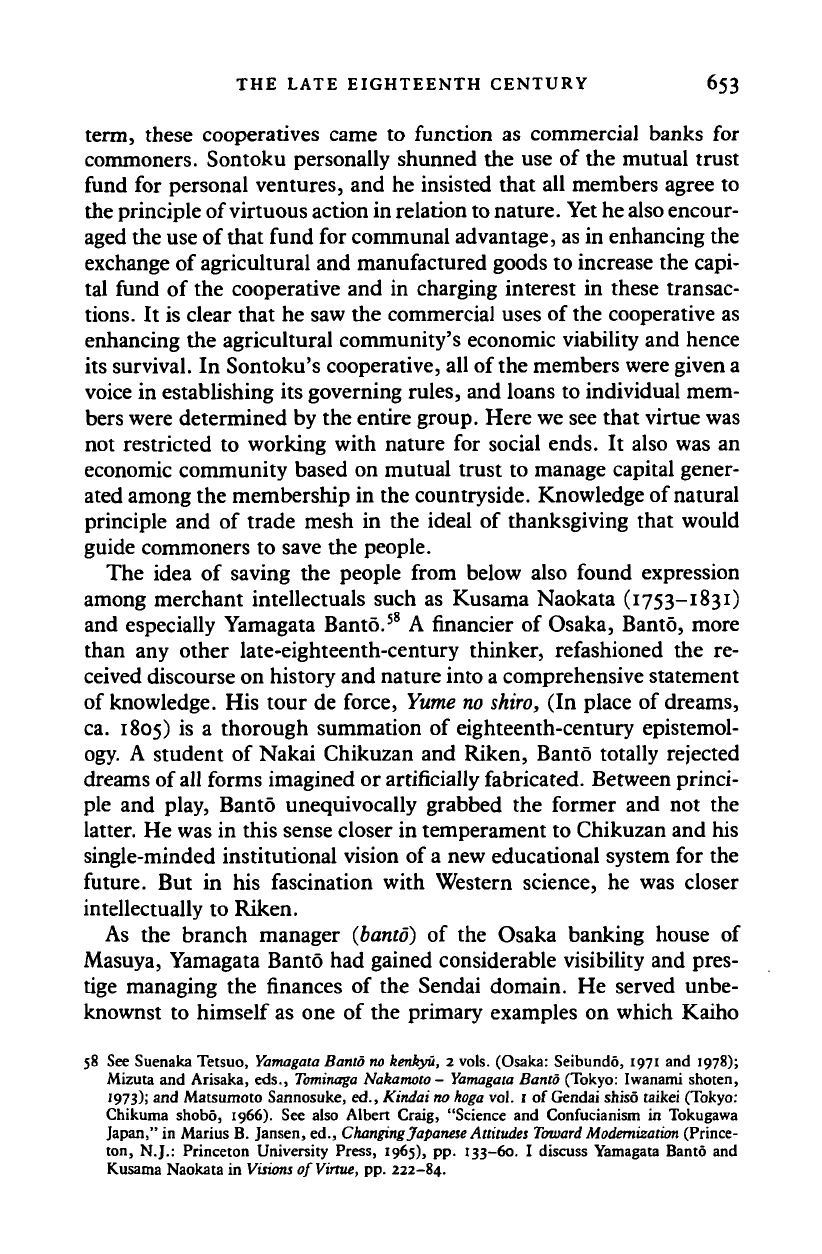
THE LATE EIGHTEENTH CENTURY 653
term, these cooperatives came to function as commercial banks for
commoners. Sontoku personally shunned the use of the mutual trust
fund for personal ventures, and he insisted that all members agree to
the principle of virtuous action in relation to nature.
Yet
he also encour-
aged the use of that fund for communal advantage, as in enhancing the
exchange of agricultural and manufactured goods to increase the capi-
tal fund of the cooperative and in charging interest in these transac-
tions.
It is clear that he saw the commercial uses of the cooperative as
enhancing the agricultural community's economic viability and hence
its survival. In Sontoku's cooperative, all of the members were given a
voice in establishing its governing rules, and loans to individual mem-
bers were determined by the entire group. Here we see that virtue was
not restricted to working with nature for social ends. It also was an
economic community based on mutual trust to manage capital gener-
ated among the membership in the countryside. Knowledge of natural
principle and of trade mesh in the ideal of thanksgiving that would
guide commoners to save the people.
The idea of saving the people from below also found expression
among merchant intellectuals such as Kusama Naokata (i753-1831)
and especially Yamagata Banto.
58
A financier of Osaka, Banto, more
than any other late-eighteenth-century thinker, refashioned the re-
ceived discourse on history and nature into
a
comprehensive statement
of knowledge. His tour de force,
Yume no
shiro,
(In place of dreams,
ca. 1805) is a thorough summation of eighteenth-century epistemol-
ogy. A student of Nakai Chikuzan and Riken, Banto totally rejected
dreams of all forms imagined or artificially fabricated. Between princi-
ple and play, Banto unequivocally grabbed the former and not the
latter. He was in this sense closer in temperament to Chikuzan and his
single-minded institutional vision of
a
new educational system for the
future. But in his fascination with Western science, he was closer
intellectually to Riken.
As the branch manager
{banto)
of the Osaka banking house of
Masuya, Yamagata Banto had gained considerable visibility and pres-
tige managing the finances of the Sendai domain. He served unbe-
knownst to himself as one of the primary examples on which Kaiho
58 See Suenaka Tetsuo, Yamagata Banto no kenkyu, 2 vols. (Osaka: Seibundo, 1971 and 1978);
Mizuta and Arisaka, eds.,
Tominaga
Nakamoto -
Yamagata
Banto (Tokyo: Iwanami shoten,
1973);
and Matsumoto Sannosuke, ed., Kindai no
hoga
vol. 1 of Gendai shiso taikei (Tokyo:
Chikuma shobo, 1966). See also Albert Craig, "Science and Confucianism in Tokugawa
Japan," in Marius B. Jansen, ed., Changing Japanese Altitudes
Toward Modernization
(Prince-
ton,
N.J.: Princeton University Press, 1965), pp. 133-60. I discuss Yamagata Banto and
Kusama Naokata in
Visions
of
Virtue,
pp. 222-84.
Cambridge Histories Online © Cambridge University Press, 2008
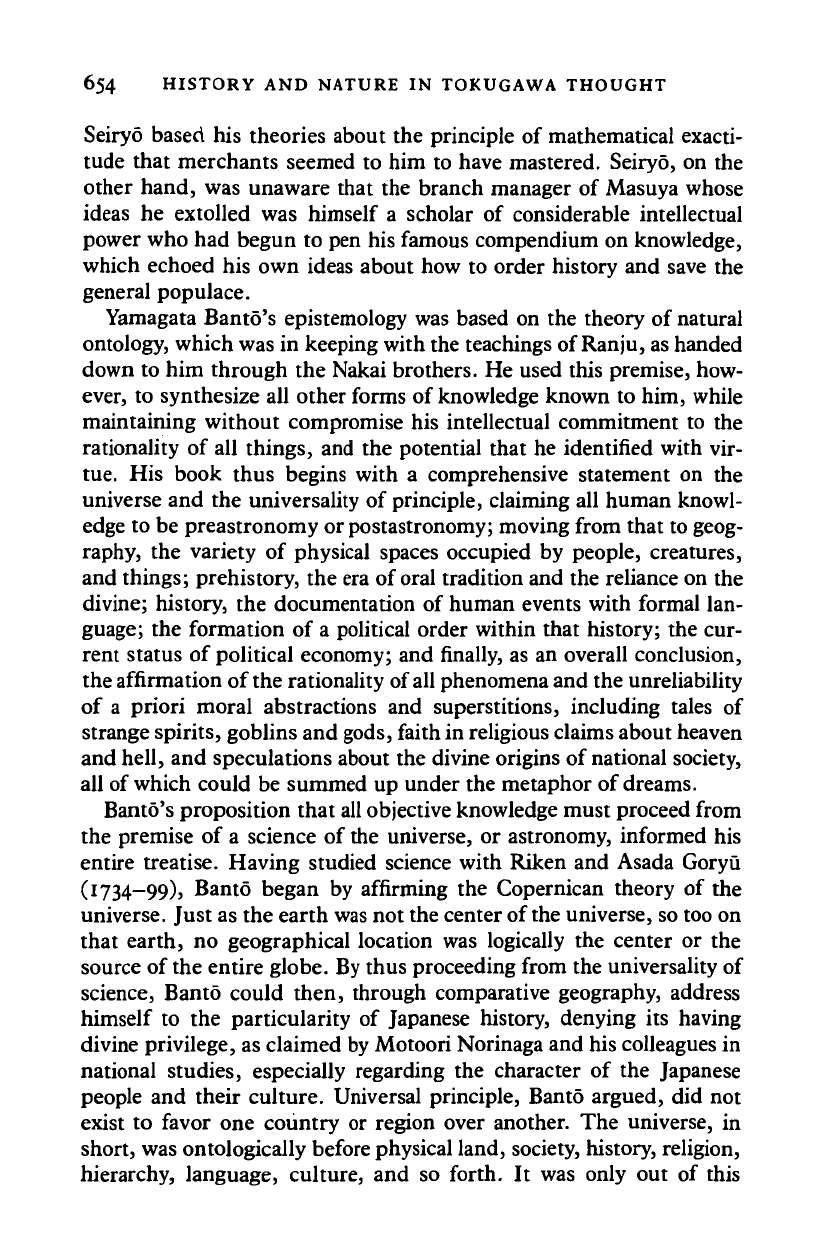
654 HISTORY AND NATURE IN TOKUGAWA THOUGHT
Seiryo based his theories about the principle of mathematical exacti-
tude that merchants seemed to him to have mastered. Seiryo, on the
other hand, was unaware that the branch manager of Masuya whose
ideas he extolled was himself a scholar of considerable intellectual
power who had begun to pen his famous compendium on knowledge,
which echoed his own ideas about how to order history and save the
general populace.
Yamagata Banto's epistemology was based on the theory of natural
ontology, which was in keeping with the teachings of Ranju, as handed
down to him through the Nakai brothers. He used this premise, how-
ever, to synthesize all other forms of knowledge known to him, while
maintaining without compromise his intellectual commitment to the
rationality of all things, and the potential that he identified with vir-
tue.
His book thus begins with a comprehensive statement on the
universe and the universality of principle, claiming all human knowl-
edge to be preastronomy or postastronomy; moving from that to geog-
raphy, the variety of physical spaces occupied by people, creatures,
and things; prehistory, the era of oral tradition and the reliance on the
divine; history, the documentation of human events with formal lan-
guage; the formation of a political order within that history; the cur-
rent status of political economy; and finally, as an overall conclusion,
the affirmation of the rationality of all phenomena and the unreliability
of a priori moral abstractions and superstitions, including tales of
strange spirits, goblins and gods, faith in religious claims about heaven
and hell, and speculations about the divine origins of national society,
all of which could be summed up under the metaphor of dreams.
Banto's proposition that all objective knowledge must proceed from
the premise of a science of the universe, or astronomy, informed his
entire treatise. Having studied science with Riken and Asada Goryu
(1734-99), Banto began by affirming the Copernican theory of the
universe. Just as the earth was not the center of
the
universe, so too on
that earth, no geographical location was logically the center or the
source of the entire globe. By thus proceeding from the universality of
science, Banto could then, through comparative geography, address
himself to the particularity of Japanese history, denying its having
divine privilege, as claimed by Motoori Norinaga and his colleagues in
national studies, especially regarding the character of the Japanese
people and their culture. Universal principle, Banto argued, did not
exist to favor one country or region over another. The universe, in
short, was ontologically before physical land, society, history, religion,
hierarchy, language, culture, and so forth. It was only out of this
Cambridge Histories Online © Cambridge University Press, 2008
